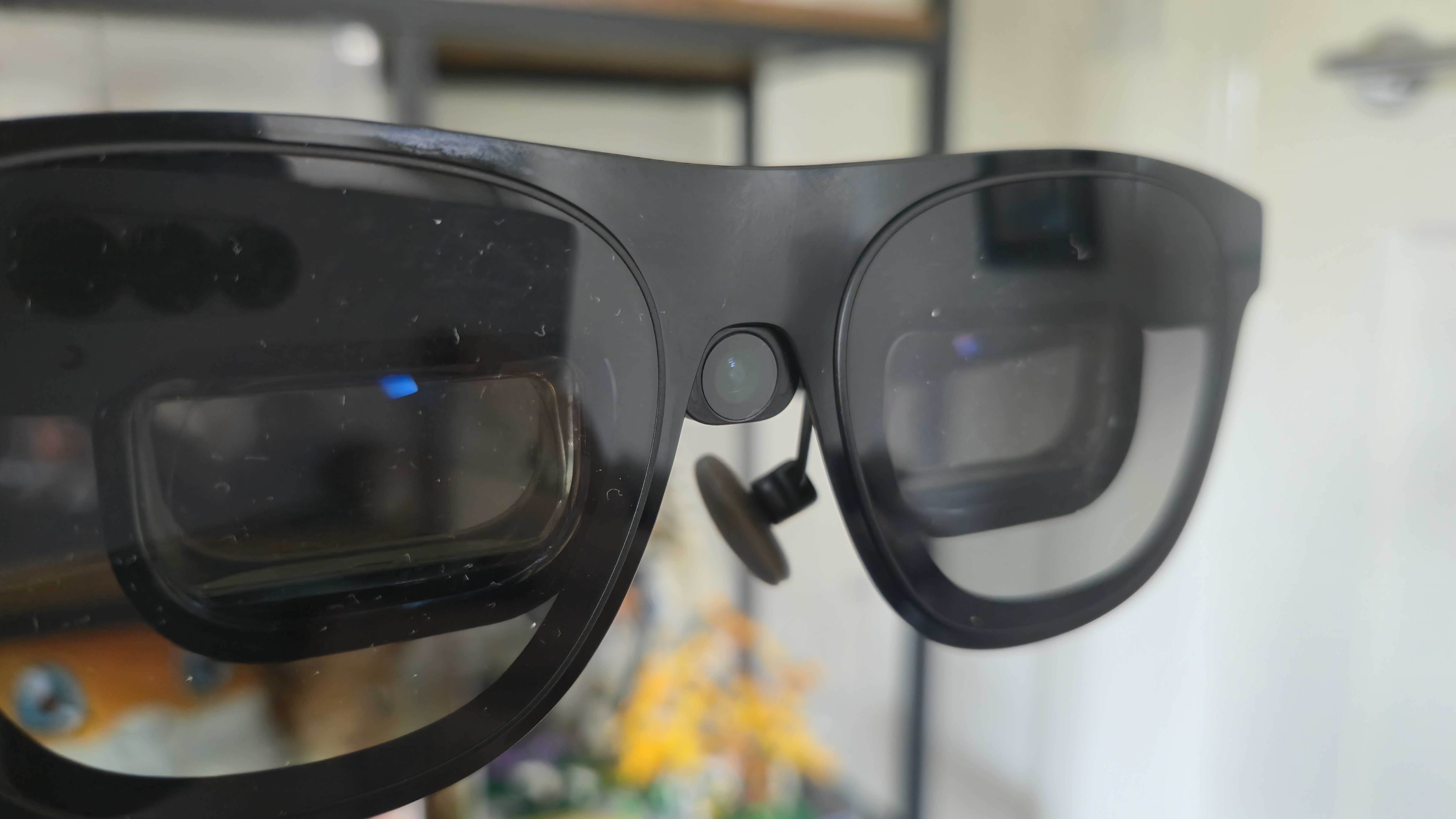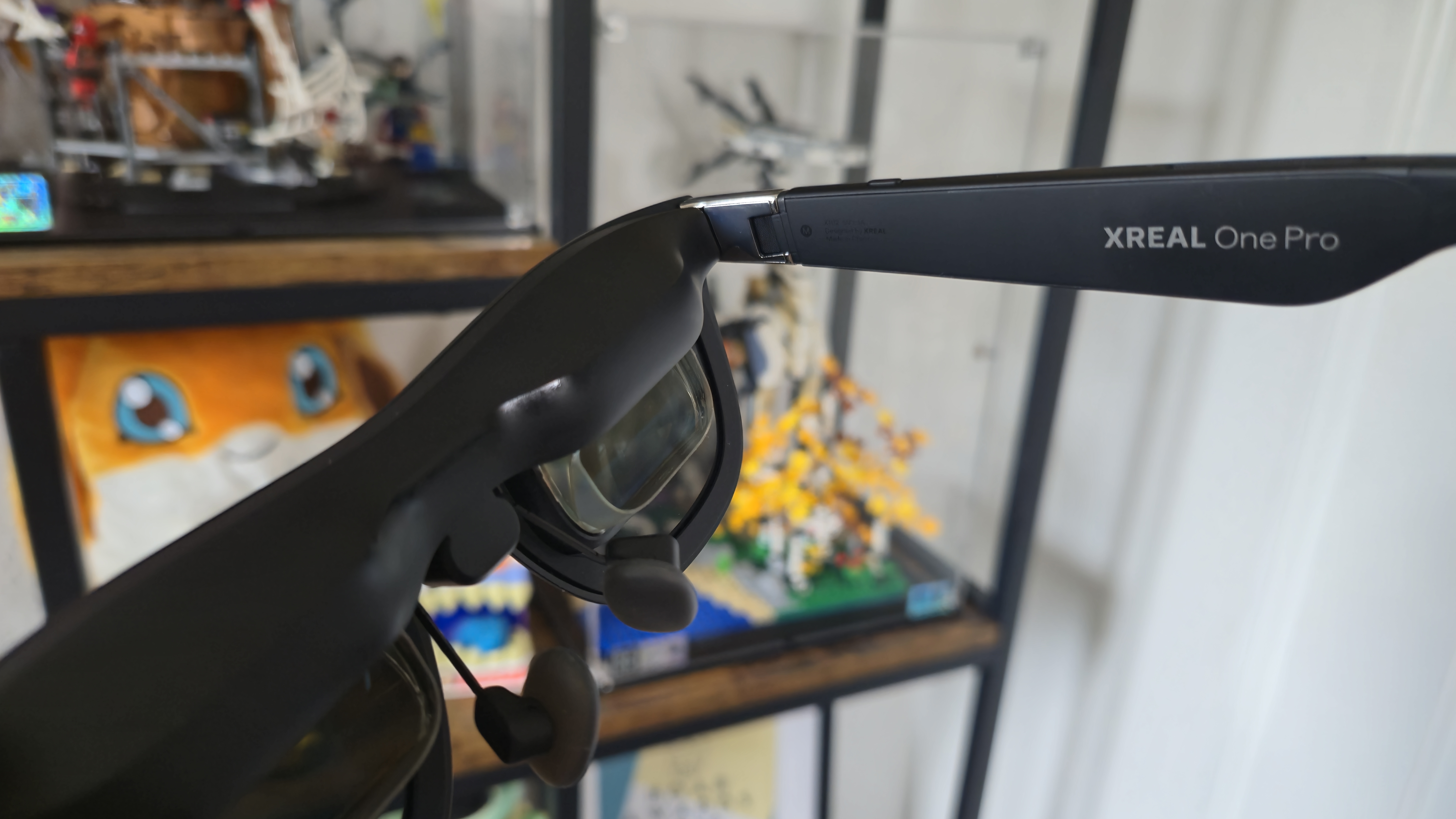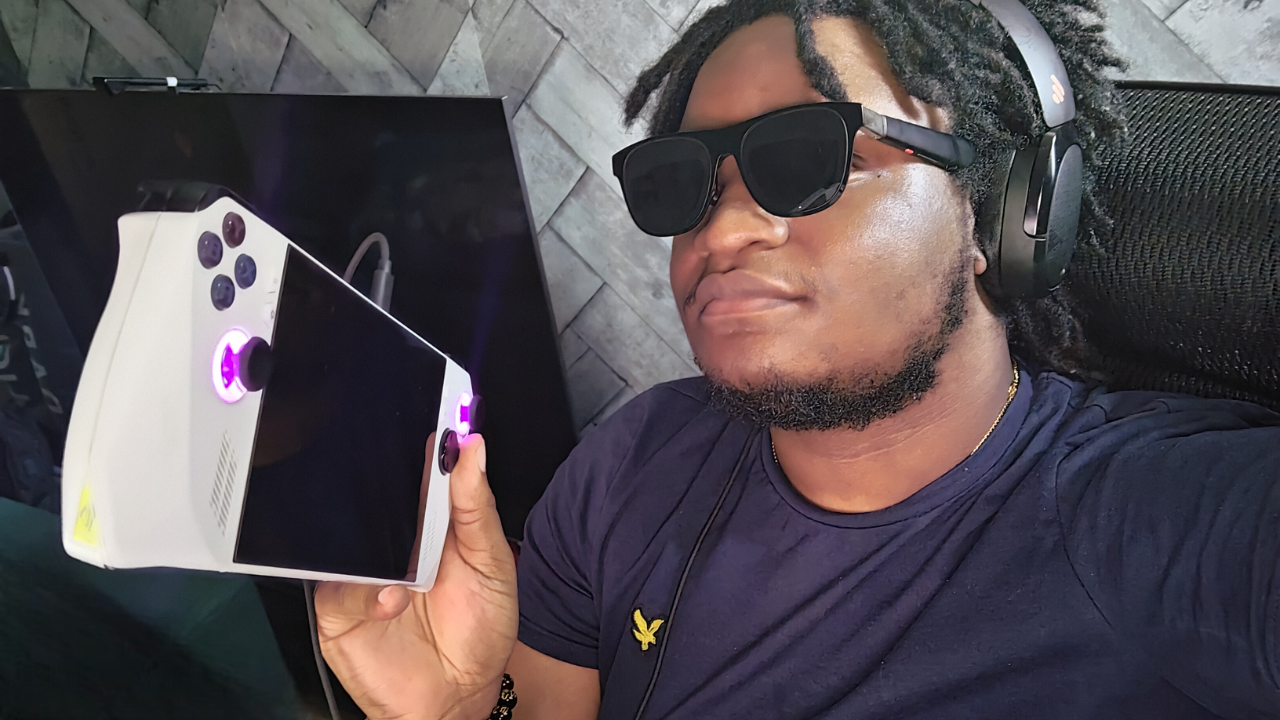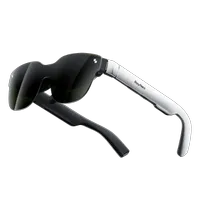TechRadar Verdict
The Xreal One Pro stands out above the crowd as the best AR smart glasses for entertainment thanks to their good Bose audio, and large full-HD image which looks better than ever thanks to a new optical engine. However the glasses are also pricier than previous models, which may put some off.
Pros
- +
Improved optical system
- +
Large field of view
- +
Great image and audio
Cons
- -
Expensive
- -
Requires other devices
- -
No 4K image
Why you can trust TechRadar
Xreal One Pro: One-minute review
After testing the Xreal One glasses I declared them the best smart glasses you could buy, and as you’d hope from an upgraded model, the Xreal One Pro glasses have just bested them.
Overall the specs are more similar than different, but the ways in which they do differ make a world of difference.
The larger 57-degree field of view allows for a bigger image – perfect for a private movie night – and the image quality is better too, thanks not only to the Pro model using the latest Sony micro-OLED displays, but also to a new optic engine which allows the specs to achieve a higher 700-nit perceived brightness, and reduces distracting reflections and blurriness.
On top of the upgrades you can also look forward to the same solid audio tuned by Bose engineers, 120Hz 1080p visuals, an electrochromically dimmable lens backdrop, and a sleek design which helps make the Xreal Ones and now the Xreal One Pros excellent.
There are just two downsides. For one, the Xreal One Pro glasses are 3g heavier than the Xreal Ones at 87g, which is admittedly a fairly minor difference. The bigger issue is that they’re pricer – these glasses will set you back $649 / £579, compared to the Xreal One's price tag of $499 / £449 (

Factor in add-on costs like the $199 / £189 Xreal Beam Pro spatial computing add-on, prescription lenses (if you need them) and extra adapters (like an HDMI to USB-C cable), and the complete Xreal One Pro package can get very expensive. You don’t need these add-ons, as the Xreal One Pro glasses come with enough in their box to use them with a wide range of compatible devices, but they're a lot better with add-ons like the Beam Pro.
That said, the Xreal One Pro are meant to be a high-end offering, and you can absolutely see what you’re paying extra for. That's why they've cemented themselves as one of the best smart glasses of 2025.
Sign up for breaking news, reviews, opinion, top tech deals, and more.
If you have the cash to splash you’ll be delighted by what the Xreal One Pro offer as an entertainment and productivity device. If, however, you’re on a budget there are more affordable options that offer excellent value for money, even if they’re not able to match the Pro’s highs.
Xreal One Pro: Price and Availability
- Costs $649 / £579
- On the pricier side of things, but boast high-end specs
A pair of Xreal One Pro glasses cost $649 / £579 which puts them on the pricier end of the smart glasses spectrum. For that you’ll get the glasses, a USB-C to USB-C cable, a cleaning cloth, and a hard carry case.
If you’re looking to level-up your AR experience you can grab the Xreal Beam Pro for $199 / £189. It’s a phone-like Android device with nifty features like a camera setup for 3D spatial photography, easy access to a suite of apps for downloading and watching shows, and two ports so you can use your glasses and charge the Beam Pro at the same time.
There’s also the Xreal Eye, priced at $99 / £99. Right now this is just a camera for snapping simple photos, but it slots into the glasses comfortably, and might allow for some other exclusive features in the future.
- Value: 4/5
Xreal One Pro: Design
- New optical design is the best yet
- Comfortable to wear for hours
At a quick glance the Xreal One Pro glasses look almost identical to the base Xreal One specs.
They both resemble typical sunglasses with a few noticeably technological features. For a start, one arm has a USB-C port at the end, via which you can tether the specs to a compatible USB-C device (like a phone, computer, or console).
Both have the same button layout – a button on the top of the right arm to quickly swap into transparency mode, as well as a brightness control button (which adjusts the electronic dimming, and the brightness of the image) and a red menu control button on the bottom.
They even have the same interchangeable nose clips and hard carry case, though their cleaning cloths are different colors (the Pro uses a gray cloth while the regular model uses black).
But one obvious change is the optical setup.

Smart glasses like this use lenses to reflect an OLED screen into your eyes so you can see the screen and what’s going on behind it. The Xreal One Pro glasses have a new shape of lens which is flat and thinner, rather than being chunky and more triangular in shape.
This means the resulting image is disrupted by fewer reflections caused by light from the world around you, and it’s able to boast a wider field of view to boot (giving you a larger virtual image – more on that below).
It’s also easier to look through these lenses when the screen isn’t in use than with the Xreal One glasses. Previously transparency mode was good for simply quickly checking your surroundings, whereas now I’m comfortable moving around while wearing the Xreal One Pro glasses in this mode.
- Design: 5/5
Xreal One Pro: Performance
- 700-nit bright 120Hz full-HD image
- Bose tuned audio from in-built speakers
- 57-degree field of view provides a giant virtual screen
The Xreal One Pro deliver a truly superb performance that’s a Pro-worthy upgrade over the base Xreal One glasses.
This is thanks to the new optical engine I touched on above, as well as new Sony OLED panels, with the two combining to deliver some top-notch specifications.
You’re getting 700 nits of perceived brightness (100 more than the Xreal One), which helps to further improve contrast and make bright scenes dazzle – qualities which are further aided by the black backdrop provided by the outer lenses with electrochromic dimming.
The field of view is now larger too, at 57 degrees. This makes the virtual screen much larger at an effective max size of 171 inches – for comparison the 50-degree Xreal One boasted a max screen size of 147 inches.
It’s further enhanced by the optical engine’s reduced blurriness and lack of reflections. The shape of lens used by other smart glasses can reflect light from the outside world into your eyes, distorting the image. Thanks to its new design the Xreal One Pro has far fewer reflections, which makes for a far superior viewing experience.
If I’m ever traveling with a pair of smart glasses again, it’ll be these – no doubt about it.

As for the audio, the Bose-tuned sound is just as impressive as it was with the Xreal One glasses.
That said, while you’ll be fine relying on the glasses’ in-built speakers when you're at home, when traveling you’ll want a pair of headphones – not only to reduce the noise from the outside world, but reduce the noise your glasses cause.
Headphones will still give you an audio upgrade when using the smart specs at home, but with the Xreal One Pro glasses (as with the Xreal Ones) they don’t feel like a necessity for a good sonic experience.
Thanks to its plethora of upgrades the only remaining gripe is that the image quality is still only 1080p (full HD) rather than 4K. 4K is a barrier other smart glasses have yet to cross, and frankly the image looks pretty darn good even at this lower resolution, and runs at 120Hz, which is nothing to sniff at.
- Performance: 5/5
Should you buy the Xreal One Pro?
Attribute | Notes | Score |
|---|---|---|
Design | The Xreal One Pro glasses don’t mix up the formula much, but there was already a lot to love and their new optical design has only elevated the experience. | 5/5 |
Performance | With a bright 700-nit 120Hz full-HD display, Bose tuned audio, and reduced reflections which make combine into first-class performance. | 5/5 |
Value | The Xreal One Pro glasses are expensive but they’re also an excellent pair of smart specs which makes them solid value for money. | 4/5 |
Buy it if...
You demand peak performance
The Xreal One Pro glasses are very very good. If you’re after the best pair money can buy for entertainment, that’s these glasses.
You want a (near) complete package
Ignoring the need for a device to connect them to, thanks to their great visuals and solid sound the Xreal One Pro glasses feel like a complete package rather than necessitating add-ons like headphones to make up for their sonic deficiencies (something which can’t be said of many of their predecessors).
You appreciate privacy
With the glasses on you can put your phone in your pocket or adjust your laptop settings to ensure only you can see your screen even in public places.
Don't buy it if...
You’re on a budget
The Xreal One Pro glasses are great, but very pricey. You can spend less on alternatives like the base Xreal One glasses or non-Xreal alternatives such as the RayNeo Air 3S and still get something good (albeit not as good).
You don’t plan to get a Beam Pro
You don’t need a Beam Pro to use the Xreal One Pro, but it’s easily the best Xreal glasses add-on out there and runs right up to the line of being a must-buy for Xreal’s specs.
You want Android XR
The Beam Pro, even with the Xreal Eye, doesn’t seem like it’ll support Android XR – if you want Xreal’s Android XR glasses you’ll need to wait a little longer for Project Aura to launch.
Also consider
Xreal One
The Xreal One AR smart glasses cost less at $499 / £449, and offer a solid HD image and Bose audio, but their overall picture quality isn't as impressive.
Read our Xreal One review
RayNeo Air 3S
These budget smart glasses punch well above their weight. Their overall quality doesn't match that of the Xreal One Pro, but if you're after the bets value pair you can find it's these.
Read our: RayNeo Air 3S review
Meta Quest 3
While not a direct competitor to the Xreal One Pro glasses, the Quest 3 is an XR product that you should consider if you want to experience what VR and MR have to offer – it’s simply superb.
Read our Meta Quest 3 review
How I tested the Xreal One Pro
I tested the Xreal One pro glasses over a couple of weeks and predominantly used them with the Xreal Beam Pro, my Samsung Galaxy Z Fold 6, and my computer.
I would also frequently use noise cancelling headphones with them as I love to wear them when travelling, but I made sure to test their in-built speakers in a range of environments to judge their performance.
I also directly compared them with the Xreal One glasses to get a sense of the upgrades the One Pros deliver.
- First reviewed: June 2025

Hamish is a Senior Staff Writer for TechRadar and you’ll see his name appearing on articles across nearly every topic on the site from smart home deals to speaker reviews to graphics card news and everything in between. He uses his broad range of knowledge to help explain the latest gadgets and if they’re a must-buy or a fad fueled by hype. Though his specialty is writing about everything going on in the world of virtual reality and augmented reality.
You must confirm your public display name before commenting
Please logout and then login again, you will then be prompted to enter your display name.



